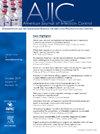给药的重要性——分析免触手卫生分配器的一致性。
IF 3.8
3区 医学
Q2 INFECTIOUS DISEASES
引用次数: 0
摘要
背景:我们调查了美国医院常见的五种免接触自动泡沫酒精洗手液(ABHR)手卫生(HH)分配器。评估输出剂量的一致性,以符合Leapfrog 2022指导要求,即每个ABHR分剂≥1.0 mL。方法:对15台配药机和32种不同的配药进行了测试,对5种不同的配药系统进行了1万支配药分析。自动化测试使用计算机编程和机电一体化来激活分配器,并在预定的延迟模式下捕获输出重量。每天的低、中、高使用模式设置为分配延迟模式。在另一个实验室,分配器被手动激活进行测量;收集50剂并在一小时内称重。结果:三个分配器系统的平均输出>1.0ml,两个是讨论和结论:发现使用/测试模式影响给药性能。分配器的设计和工程导致不同分配器的体积和一致性存在显著差异。使用足够的ABHR完全覆盖双手并保持足够长的手湿以显著减少病原体是一项重要要求。设施应评估ABHR分配器的输出,并考虑将一致的剂量作为有效卫生政策和实践的基本绩效标准。本文章由计算机程序翻译,如有差异,请以英文原文为准。
Importance of dosing: Analysis of touch-free hand hygiene dispensers for consistency
Background
We investigated 5 touch-free automatic foam alcohol-based handrub (ABHR) hand hygiene dispensers common in US hospitals. Output dosing was evaluated for consistency to comply with the Leapfrog 2022 guidance requirement of ≥ 1.0 mL per ABHR dispense.
Methods
Fifteen dispensers and 32 distinct refills were tested, with > 10,000 dispenses analyzed for 5 different dispensing systems. Automated testing used computer programming and mechatronics to activate the dispensers and capture output weights at predetermined delay patterns. Low, medium, and high usage patterns per day were set with dispense delay patterns. In another laboratory, dispensers were activated manually for measurements; 50 doses were collected and weighed within an hour for each refill.
Results
Three of the dispenser systems had mean output > 1.0 mL, and 2 were < 1.0 mL. Two dispensers have significantly greater variability, which is driven by the foam pump design.
Conclusions
It was discovered that usage/testing patterns impact dosing performance. The dispenser design and engineering cause significant differences in volume dispensed and consistency across dispenses. Using sufficient ABHR to cover hands completely and keeping hands wet long enough to significantly reduce pathogens is an important requirement. Facilities should assess ABHR dispenser outputs and consider consistent dosing as an essential performance criterion for effective hand hygiene policies and practices.
求助全文
通过发布文献求助,成功后即可免费获取论文全文。
去求助
来源期刊
CiteScore
7.40
自引率
4.10%
发文量
479
审稿时长
24 days
期刊介绍:
AJIC covers key topics and issues in infection control and epidemiology. Infection control professionals, including physicians, nurses, and epidemiologists, rely on AJIC for peer-reviewed articles covering clinical topics as well as original research. As the official publication of the Association for Professionals in Infection Control and Epidemiology (APIC)

 求助内容:
求助内容: 应助结果提醒方式:
应助结果提醒方式:


